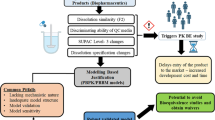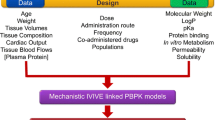Abstract
Modelling and simulation (M&S) play an important role in regulatory decision-making that affects both the public and industry. Technological advances in various fields related to drug development call for more focus on ways to optimise current drug development practices. Recognition of the potential of M&S by regulatory agencies inevitably has a substantial impact on drug development. The objective of the current review is to present the various regulatory initiatives for application of M&S to clinical drug development. The relevant parts of the various recommendations issued by the US Food and Drug Administration (FDA), via guidance documents and advisory committee meeting proceedings, are highlighted. Application of M&S to a variety of activities, such as integrating pharmacokinetic-pharmacodynamic knowledge across a new drug application and designing efficient trials, is discussed. Some of the challenges that pharmaceutical institutions currently face when implementing M&S projects, such as team structure, communication with regulators, training and time constraints, are also presented, and solutions are, proposed.


Similar content being viewed by others
References
Hale M, Gillespie WR, Gupta SK, et al. Clinical trial simulation: streamlining your drug development process. Appl Clin Trial 1996; 5: 35–40
Peck CC, Desjardins RE. Simulation of clinical trials: encouragement and cautions. Appl Clin Trial 1996; 5(9): 30, 32
Peck CC. Does the current development find the right dose?. US Food and Drug Administration: cardiovascular and renal drugs advisory committee meeting; 2000 Oct 20; Bethesda, MD [online]. Available from URL: http://www.fda.gov/ohrms/dockets/ac/00/transcripts/3656t2a.pdf [Accessed 2001 Nov 6]
Sheiner LB, Steimer J-L. Pharmacokinetic/pharmacodynamic modeling in drug development. Annu Rev Pharmacol Toxicol 2000; 40: 67–95
Holford NHG, Kimko HC, Monteleone JPR, et al. Simulation of clinical trials. Annu Rev Pharmacol Toxicol 2000; 40: 209–34
Gobburu JVS, Jusko WJ. Role of dosage regimen in controlling indirect pharmacodynamic responses. Adv Drug Deliv Rev 1998; 33: 221–33
Office of Clinical Pharmacology and Biopharmaceutics Review, Center for Drug Evaluation and Research, US Food and Drug Administration, 1999 [online]. Available from URL: http://www.fda.gov/cder/foi/nda/99/21019A_Compazine_chemr_clinphrmr.pdf [Accessed 2001 Nov 6]
El-Tahtaway AA, Jackson AJ, Ludden TM. Evaluation of bioequivalence of highly variable drugs using Monte Carlo simulations. I: estimation of rate of absorption for single and multiple dose trials using Cmax. Pharm Res 1995; 12: 1634–41
Efron B, Tibshirani R. The bootstrap method for assessing statistical accuracy. Stanford (CA): Stanford University, 1985. Report no.: 101
Jusko WJ. Pharmacodynamics of chemotherapeutic effects: dose-time-response relationships for phase-nonspecific agents. J Pharm Sci 1971; 60: 892
Garrett ER. Kinetics of antimicrobial action. Scand J Infect Dis Suppl 1978; 14: 54–85
Holford NHG, Peace KE. Results and validation of a population pharmacodynamic model for cognitive effect in Alzheimer patients treated with tacrine. Proc Natl Acad Sci U S A 1992; 89: 11471–5
Guihenneuc-Jouyaux C, Richardson S, Longini Jr IM. Modeling markers of disease progression by a hidden Markov process: application to characterizing CD4 cell decline. Biometrics 2000; 56(3): 733–41
Levy G. Kinetics of pharmacologic effects. Clin Pharmacol Ther 1966; 7: 362–72
Sheiner LB, Stanski DR, Vozeh S, et al. Simultaneous modeling of pharmacokinetics and pharmacodynamics: application to d-tubocurarine. Clin Pharmacol Ther 1979; 25: 358–71
Holford NHG, Sheiner LB. Pharmacokinetic and pharmacodynamic modeling in vivo. CRC Crit Rev Bioeng 1981; 5: 273–322
Gibaldi M, Perrier D. Pharmacokinetics. 2nd ed. New York: Marcel Dekker, 1982
Dayneka NL, Garg V, Jusko WJ. Comparison of four basic indirect response models. J Pharmacokinet Biopharm 1993; 21: 457–78
Pauler DK, Laird NM. A mixture model for longitudinal data with application to assessment of noncompliance. Biometrics 2000; 56: 464–72
International Conference on Harmonisation of Technical Requirements for the Registration of Pharmaceuticals for Human Use (ICH). Dose-response information to support drug registration: ICH E4 [online]. Available from URL: http://www.fda.gov/cder/guidance/iche4.pdf [Accessed 2001 Nov 6]
United States Food and Drug Administration Modernization Act 1997 [online]. Available from URL: http://www.fda.gov/cdrh/modact97.pdf [Accessed 2001 Nov 6]
Center for Drug Evaluation and Research, US Food and Drug Administration. Guidance for industry: providing clinical evidence of effectiveness for human drug and biological products, 1999 [online]. Available from URL: http://www.fda.gov/cder/guidance/1397fnl.pdf [Accessed 2001 Nov 6]
Center for Drug Evaluation and Research, US Food and Drug Administration. Guidance for industry: qualifying for pediatric exclusivity under section 505A of the Federal Food, Drug, and Cosmetic Act [online]. Available from URL: http://www.fda.gov/cder/guidanc/2891fnl.htm#X [Accessed 2001 Nov 6]
Antiviral Drugs Advisory Committee. 2000 Jul 25, [online] Available from URL: http://www.fda.gov/ohrms/dockets/ac/00/agenda/3621al.pdf [Accessed 2001 Nov 19]
Gobburu JVS, Lipicky RJ. Dose-response relationship characterization in current drug development: do we have a problem? Part I: inferences from animal and human data, 2000 [online]. Available from URL: http://www.fda.gov/ohrms/dockets/ac/00/backgrd/3656b2a.pdf 2000 [Accessed 2001 Nov 7]
Center for Drug Evaluation and Research, US Food and Drug Administration. Guidance for industry: population pharmacokinetics, 1999 [online]. Available from URL: http://www.fda.gov/cder/guidance/1852fnl.pdf [Accessed 2001 Nov 7]
Sun H, Fadiran EO, Jones CD, et al. Population pharmacokinetics: a regulatory perspective. Clin Pharmacokinet 1999; 37(1): 41–58
Gobburu JVS. Regulatory perspective on clinical trial simulations. Annual Meeting of the American Association of Pharmaceutical Scientists; 2000 Oct 29–Nov 2; Indianapolis 2000
Schaefer HG, Heinig R, Ahr G, et al. Pharmacokinetic-pharmacodynamic modelling as a tool to evaluate the clinical relevance of a drug-food interaction for a nisoldipine controlled-release dosage form. Eur J Clin Pharmacol 1997; 51(6): 473–80
Bruno R, Hille D, Riva A, et al. Population pharmacokinetics/pharmacodynamics of docetaxel in phase II studies in patients with cancer. J Clin Oncol 1998; 16(1): 187–96
Sheiner LB, Hashimoto Y, Beal SL. A simulation study comparing designs for dose ranging. Stat Med 1991 Mar; 10(3): 303–21
Malinowski H, Marroum PJ, Uppoor R, et al. Draft guidance for industry extended-release solid oral dosage forms: development, evaluation and application of in vitro-in vivo correlations. Adv Exp Med Biol 1997; 423: 269–88
Veng-Pedersen P, Gobburu JVS, Meyer MC, et al. Carbamazepine level A in vitro-in vivo correlation (IVIVC): a scaled convolution based predictive approach. Biopharm Drug Disp 2000; 21: 1–6
Marroum PJ. Regulatory examples: dissolution specifications and bioequivalence product standards. In: Amidon G, Robinson JR, Williams RL, editors. Scientific foundations for regulating drug product quality. Alexandria (VA): AAPS Press, 1997: 305–19
Marroum PJ. Role of in vitro in vivo correlations in setting dissolution specifications. Am Pharm Rev 1999; 2(4): 39–42
Law AM, Kelton WD. Simulation modeling and analysis. 2nd ed. New York: McGraw-Hill Inc., 1991
Gelman A, Meng X-L, Stern H. Posterior predictive assessment of model fitness via realized discrepancies. Stat Sin 1996; 6: 733–807
Gobburu JVS, Holford NHG, Ko HC, et al. Model optimization via ‘lateral validation’ for purposes of clinical trial simulations [abstract]. Clin Pharmacol Ther 1999; 65(2): 164
Nagashima R, O’Reilly RA, Levy G. Kinetics of pharmacologic effects in man: the anticoagulant action of warfarin. Clin Pharmacol Ther 1969; 10: 22–35
Jackson RC. A pharmacokinetic-pharmacodynamic model of chemotherapy of human immunodeficiency virus infection that relates development of drug resistance to treatment intensity. J Pharmacokinet Biopharm 1997; 25(6): 713–30
Ette EI. Stability and performance of a population pharmacokinetic model. J Clin Pharmacol 1997 Jun; 37(6): 486–95
Yafune A, Ishiguro M. Bootstrap approach for constructing confidence intervals for population pharmacokinetic parameters. I: a use of bootstrap standard error. Stat Med 1999 Mar 15; 18(5): 581–99
Lipicky RJ. US Food and Drug Administration: cardiovascular and renal drug products advisory committee meeting; 2000 Oct 20; Bethesda, MD [online]. Available from URL: http://www.fda.gov/ohrms/dockets/ac/00/transcripts/3656t2b.pdf [Accessed 2001 Nov 7]
Machado SG, Miller R, Hu C. Aregulatory perspective on pharmacokinetic/pharmacodynamic modelling. Stat Methods Med Res 1999 Sep; 8(3): 217–45
Machado SG, Murray GD, Teasdale GM. Evaluation of designs for clinical trials of neuroprotective agents in head injury. European Brain Injury Consortium. J Neurotrauma 1999 Dec; 16(12): 1131–8
Lesko LJ, Rowland M, Peck CC, et al. Optimizing the science of drug development: opportunities for better candidate selection and accelerated evaluation in humans. Eur J Pharm Sci 2000; 10(4): iv-xiv
Sheiner LB. Dose finding: what do we want to know? US Food and Drug Administration: cardiovascular and renal drug products advisory committee meeting; 2000 Oct 20; Bethesda, MD [online]. Available from URL: http://www.fda.gov/ohrms/dockets/ac/00/transcripts/3656t2b.pdf [Accessed 2001 Nov 7]
Office of Drug Evaluation IV, US Food and Drug Administration. Pre-investigational new drug application (IND). Consultation Program [online]. Available from URL: http://www.fda.gov/cder/ode4/preind [Accessed 2001 Nov 7]
Acknowledgements
The views expressed in this article are those of the authors and do not reflect the official policy of the FDA. No official endorsement by the FDA is intended or should be inferred.
Author information
Authors and Affiliations
Corresponding author
Rights and permissions
About this article
Cite this article
Gobburu, J.V.S., Marroum, P.J. Utilisation of Pharmacokinetic-Pharmacodynamic Modelling and Simulation in Regulatory Decision-Making. Clin Pharmacokinet 40, 883–892 (2001). https://doi.org/10.2165/00003088-200140120-00001
Published:
Issue Date:
DOI: https://doi.org/10.2165/00003088-200140120-00001




